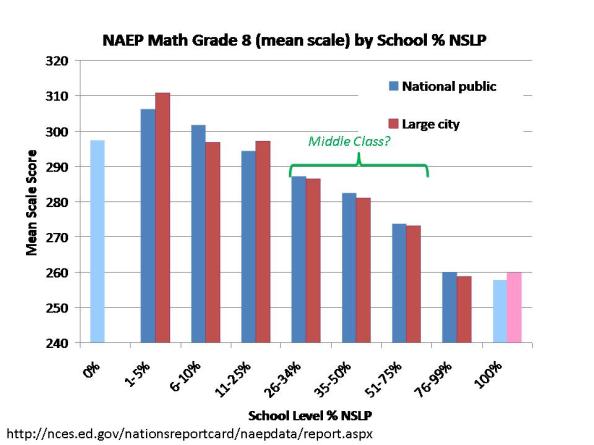Newsflash! "Middle Class Schools" score..uh...in the middle! Opps! No News here!
I’ve already beaten the issue of the various flaws, misrepresentations and outright data abuse in the Third Way middle class report into the ground on this blog. And it’s really about time for that to end. Time to move on. But here is one simple illustration which draws on the same NAEP data compiled and aggregated in the Middle Class report. For anyone reading this post who has not already read my others on the problems with the definition of “Middle Class,” and related data abuse & misuse please start there:
My NEPC Response to Third Way Memo regarding Methods
My blog response to the argument that I’m simply a Status-quo-er
Again, the entire basis of the Third Way report is that our nation’s middle class schools are under-performing… not meeting expectations… dismal…dreadful… failures! Now, setting aside the absurd methods used for classifying “middle class” and setting aside that the report mixes units of analysis illogically throughout (districts vs. schools vs. individual families, regardless of district or school attended) and mixes data across generations of high school graduates, how did they really expect middle class schools to perform? Did they expect them NOT to be IN THE MIDDLE? That seems rather foolish. No, wait, it is entirely foolish!
Here’s one very simple example showing the NAEP 8th grade math mean scale scores of children in 2009 by the percent of children in their school who qualify for the National School Lunch Program:
Rather amazingly, what we see here is that as school level % low income increases, NAEP mean scale scores decrease. Interestingly, the NAEP reporting tool chooses to include anomalous categories of 0% and 100%, which, not surprising, don’t fall right in line. Across the low income brackets, but for the anomalous endpoints, the relationship is nearly linear – with mean scale scores declining incrementally from the 1 to 5% low income group to the 76 to 99% category. Note also, that consistent with my previous explanations, the supposed “middle class” is actually to the right hand side – poorer side – of the distribution.
Most importantly… and really no freakin’ surprise… in fact something I shouldn’t ever even have to graph in order to validate it – THE SUPPOSED “MIDDLE CLASS” SCHOOLS FALL WHERE? RIGHT IN LINE! RIGHT IN THE DAMN MIDDLE OF THE CATEGORIES ON EITHER SIDE OF THEM? HOW THE HECK IS THAT PERFORMING UNDER EXPECTATIONS? THAT, MY FRIENDS, IS LUDICROUS! IT’S RIGHT ON EXPECTATIONS – STATISTICALLY!
Whether we as a country are, or whether I specifically am happy with the level or distribution of outcomes in the above figure is an entirely different issue. I might want to see higher outcomes across the board. Personally, I’d love to see the resources leveraged to begin to raise the outcomes on the right hand side of the graph – to reduce the clear linear relationship between low income concentrations and student outcomes. But I also understand that the national aggregate relationship shown in the figure above has underlying it, the embedded disparities of 50 unique state education systems – some where states are making legitimate efforts to provide resources to improve equity in educational outcomes, and others quite honestly, that have done little or nothing for decades and in some cases have systematically eroded the equity and adequacy of resources over time (well before the current fiscal crisis)!
Fixing these disparities is a large and complex task and one that is not aided by small minded rhetoric and flimsy oversimplified analyses.
This blog post has been shared by permission from the author.
Readers wishing to comment on the content are encouraged to do so via the link to the original post.
Find the original post here:
The views expressed by the blogger are not necessarily those of NEPC.

